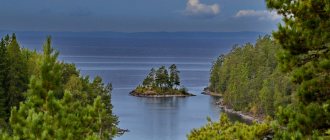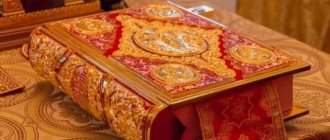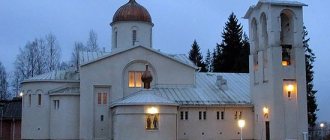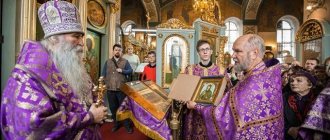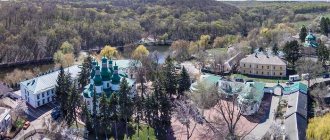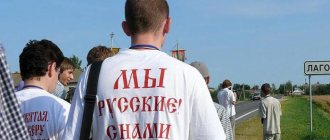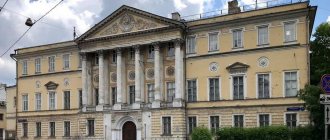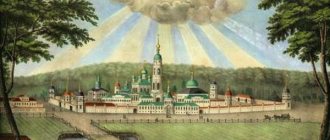The history of these places reached contemporaries only through legends, according to which the emergence of Christianity on Valaam coincided with the baptism of Rus'.
Balaam attracted the pagans with his beauty and grandeur. It was here that they located their temple - the main place of worship of the most revered of the gods.
Historians believe that the first Christians to visit these places were Sergius and Herman. They had the status of monks, which means that they wore a cassock, but were not monks. In fact, they were junior monks before they were tonsured into the minor schema.
Valaam Monastery
The Valaam Wonderworkers prayed and worked hard, which enabled them to lay the foundation of a monastery that meant so much to their contemporaries. Sergius and Herman belonged to the Greek church, and Valaam itself territorially belonged to the lands of Veliky Novgorod.
Where is the monastery located on the map of Russia
A scattering of islands of the Valaam archipelago, on one of which the main monastery is located, is located in Lake Ladoga in the northwestern part of Russia. In addition, there are smaller islands where you can find quite secluded and praying hermitages - small temple villages that were erected on the places where hermit monks lived.
There are a lot of hermitages in these northern regions. There are those that are more famous than others. You can get to less popular places that are still interesting. Such excursions can always be arranged in the main temple complex. Sometimes private visits to distant shrines can be arranged.
Map of the Valaam archipelago
O. Valaam is located near a large city - St. Petersburg. Most pilgrimage tours are organized along a direct route. But if you get there on your own, then from the Northern capital you can go to Valaam almost any day on specially organized train or bus routes.
The departure to Valaam is on schedule, since you can only get to the Valaam Monastery by ferry. Routes are organized from the lakeside towns of the northern Ladoga region. The most popular pier is located in the city of Priozersk.
Description
For believers, the Valaam Monastery is a special place. The building is surrounded by water on all sides and removed from the city limits, which makes this place truly peaceful and quiet.
The island is located two dozen kilometers from the mainland, forty-two kilometers from the nearest city and two hundred kilometers from the cultural heart of Russia - St. Petersburg.
Valaam Monastery
The nature of Valaam surprises and amazes: almost five hundred species of plants, two hundred species of birds, many animals. Here you can also find species listed in the Red Book, for example, seals. The main part of the island is occupied by coniferous forests. There are also deciduous trees, but people brought them.
The inhabitants of Valaam always led a peaceful life, even when they were subjected to attacks and hardships. At the dawn of the seventeenth century, the monastery was captured and destroyed by the Swedes. The island belonged to this country before the Northern War.
In the eighteenth century, Abbot Nazarius introduced the Strict Rule, which was followed by many generations of novices. It provided for three forms of life for a monk: hermit, monastery and cenobitic. By the beginning of the twentieth century, the monastery already had thirteen hermitages scattered throughout Valaam.
We recommend reading:
Sights of Singapore
The main building of the monastery is located on a hill. This is an interesting architectural ensemble, the heart of which is the Transfiguration Cathedral. Around it there are fraternal cells, and further down the hill there are gardens. The cathedral has a cross-domed structure and is divided into three naves. The bell tower has several tiers; formerly there were thirteen bells, now there is only one.
Valaam Monastery
History of the Valaam Monastery
The history of the creation of the temple complex on Valaam is unusually rich. Like many ancient places, Valaam also has many traditions and legends, which today are not possible to confirm or refute. But the truth remains that these stories are passed down from generation to generation, carefully preserved by the monks who dedicated their lives to serving God in this wonderful place.
This is interesting: why did these places become holy and are highly revered in Orthodox Christianity? They say that one of the disciples of Jesus Christ, Andrew the First-Called, visited Valaam. He established in these northern lands on Mount Fr. Valaam stone cross, when the Dnieper and Volkhov passed, spreading the ideas of Christianity to the North.
Further details about the foundation of the monastery are unknown. The first story says that 900 years after the journey of St. Andrew the First-Called, two monks, Sergius and Herman, founded a monastery on the island. They probably arrived in these northern lands from Greece. But this legend is transmitted orally, and all written confirmations are irretrievably lost.
The second story says that back in the 10th-11th centuries, the Monk Abraham of Rostov settled on the island. His lives and some surviving chronicle materials say that the relics of the founders of the shrine, Sergius and Germanus, were transferred from the island to Novgorod in the 12th century.
If we rely on verified sources that have survived to this day, we can say that the founding date of the Valaam Monastery is 1407. This date is given in the letters of Savvaty Solovetsky, who lived in these places. It is known that the 16th century saw an unprecedented flowering of these places. About 600 monks lived permanently on the temple grounds. But frequent attacks by the Swedes led to the fact that the temple complex was empty for a long time.
Then, only at the beginning of the 18th century, the monastery began to acquire great importance. By that time, the borders of the Russian Empire were being formed in Karelia and the Baltic states, and Peter I paid special attention not only to the construction of the new capital of the state, but also to the surrounding territories.
It was then that the shrine acquired a new look, and special efforts began to be made to populate the monastery. By 1730, the Assumption Church appeared on the island, and the complex was surrounded by a fence for protection. However, difficult circumstances intervened again, and a big fire in 1754 consumed most of the monastery’s buildings.
But Empress Elizaveta Petrovna did not give up attempts to restore the ancient holy monastery. Despite great efforts and attention from the top leadership of the state, the Valaam monastery, a few years after the fire, numbered just over a dozen monks living there permanently.
Church of the Transfiguration of the Lord
But still, a lot was done to improve the holy place. Already in 1774, the monastery began to acquire its modern appearance. By this year, a new stone Church of the Transfiguration of the Lord was erected. Around, on all sides, like the walls of a fortress, buildings grew up in which the monks' cells were located. The Assumption Church was built again in the corners, and St. Nicholas Church on the other side. The first of them was used for worship and sacraments in the winter, as it was heated.
In general, at the end of the 18th century and throughout the 19th century, the Valaam Monastery was constantly developing, building and growing. His influence also increased. It is known that in those days many priests sought to stay on Valaam. So, out of 20 arriving monks, at best, one clergyman remains.
Church of Peter and Paul
At the beginning of the 19th century, the Church of Peter and Paul was erected above the gates of the complex. In the northern part, a hospital church was built in the name of the icon of the Mother of God. Since then, there has been a majestic belfry on the island, the bell tower of which reaches 72 meters in height.
In the 20th century, long and very difficult times came for the Valaam temple complex. At first, by the 30s of the century, about 300 monks, 100 workers and hired workers served there. But in these times the territory of Fr. Valaam was given to the then newly formed Finland. Officially, the complex continued to operate, but from then on it was considered to represent the faith of a minority of citizens of the new country. This provoked numerous persecutions and oppression of local clergy.
It is worth noting: one interesting fact is known about the pressure of the Finnish authorities on Valaam. Thus, the rector of the temple, Archbishop Seraphim, was instructed to learn the Finnish language in three months. But at the specified time the priest did not appear for the exam. Angry authorities deported the bishop to Fr. Konevets.
Long-term oppression and persecution could not go unnoticed. More and more ministers began to leave the monastery. Most accepted citizenship of the new country and left. In 1940, after the end of the short conflict between Finland and the USSR, Ladoga heard twelve strikes of the bell. This put an end to the life of the monastery. Many monks left Valaam and went to other countries: Greece, Serbia, Finland.
How to pray correctly in front of the Valaam icon of the Most Holy Theotokos
The rules of prayer to the miraculous Mother of God are not much different from general Orthodox regulations.
The icon of the Mother of God (with Valaam or other origin) helps those people who really need help. Ancient icons are a serious means of healing ailments. The more time you spend in front of such icons, the better (the images of the Valaam masters are no exception).
To achieve what you want through prayer, adhere to the following rules:
- Stand at the Valaam Icon with an open heart, do not be deceitful.
- Prayer should be pure, think about the Mother of God, and not about vain things.
- The church recommends placing candles in front of the icons; the mistress will like it.
- Please note that no one guarantees you heavenly intercession, be patient.
- Do not forget to ask the Mother of God for help in overcoming destructive passions.
- If you ask the Mother of God to heal a loved one, the likelihood of recovery increases.
- Before visiting the Valaam lands, confess.
- Do not forget to ask our God for healing the rest of the time.
- The Mother of God of Valaam helps only true believers - those who have already accepted Jesus into their hearts.
- Before any icons you need to cross yourself, ensuring the proper level of respect.
Soviet period and modern times
Many people know that the USSR authorities did not support Orthodoxy. Faith fell into a long period of timelessness, an almost underground existence. But this does not mean that the island of Valaam was not inhabited. However, his story still remained sad and unenviable.
During the Great Patriotic War, a boatswain's school was located in the cells of the monastery. In 1944, its graduates went to break the siege of Leningrad. Afterwards, forestry was located here for a short period of time, then pulp production.
In 1950, a home for war veterans was organized on the island. Unfortunately, many of them were sent here forcibly, away from the eyes of the authorities, who sought to quickly forget the consequences of the Second World War. The establishment was transferred from the island only in 1984. Only on December 13, 1989, six monks arrived in Valaam for permanent service.
From this time on, services began to be held in churches, and the Valaam Monastery again began to gain great popularity. Some buildings that have fallen into disrepair are gradually being repaired and improved. In 2005, during the restoration of the belfry, the bell “St. Andrew the First-Called” was hung. It has a mass of 16 tons.
Please note: today the shrine is visited by more than one hundred thousand tourists annually. Every tenth visitor arrives here as part of pilgrimage groups.
Hermitages on Valaam and nearby islands
The largest skete on Valaam is the Skete of All Saints. Also known as the Great Hermitage or the White Hermitage. It is known that it was built first.
The complex is a beautiful temple made of stone, as well as cells for ministers. Keep in mind that women can visit the monastery only once a year: on the first Sunday after Trinity, everyone is allowed here. In February 2004, the house church was illuminated, which can be accessed through the entrance on the other side of the monastery.
The monastery of John the Baptist differs from others in its special, strict regulations. Outsiders are not allowed here.
Resurrection Skete
It is worth paying close attention to the Resurrection Skete, standing on the mountain on which, according to legend, St. Andrew the First-Called erected a stone cross.
A little less known are other complexes that, for various reasons, were destroyed or dismantled to the ground, but then restored. These are Konevsky, Avraamievsky, Alexander-Svirsky monasteries.
Alexander-Svirsky monastery
The latter, by the way, was erected on the site where the hermit Alexander Svirsky lived for a long time in a cave. In 1999, there was a fire in the monastery, which caused significant damage to the buildings. But in 2001 the building was completely restored.
The Valaam monastery with its adjacent monasteries on numerous islands is today experiencing a new period of prosperity. The Orthodox Church is doing a lot to restore these holy places.
Temple of Alexander Nevsky
Thus, today many new monasteries are being built in places that are of great importance for the Christian faith. Today the following are being built: the Kazan monastery, the monasteries of Alexander Nevsky, the Apostle Andrew the First-Called, and Herman of Alaska.
There are places that are not included in generally accepted pilgrimage routes, but you can visit them after receiving the blessing of the monastery abbots. Among them, such monasteries are known as Germanovsky (located at a great distance from the Valaam Monastery, it is now in a dilapidated state), Sergievsky, Tikhvinsky (a very holy place, but nothing remains of the buildings on the island, since during Soviet rule the complex was completely disassembled).
What to see. List of attractions
The attractions of Valaam include not only various buildings, but also unique natural landscapes. But the main thing is the monasteries. Here are just a few of them:
Nikolsky Skete - was built in 1853.
St. Vladimir's monastery built in 2007.
Gethsemane Monastery, built in 1911.
The Skete of All Saints, which is the first and was built at the end of the 18th century.
And of course the main object is the Spaso-Preobrazhensky Monastery. It is worth noting that not all monasteries and objects of Valaam are open to the public; some have a number of restrictions. The rules may change, so it is better to look at them on the official website of the monastery. By the way, you can also watch a 3D tour of Valaam there.
In principle, it is possible to see all the most interesting things in one day, but a few hours will definitely not be enough for you. Therefore, it’s definitely not worth going to the Valaam archipelago for a couple of hours; you plan to spend more time.
It is also worth noting here that if you are traveling to Valaam, then, if possible, it is worth planning a visit to other attractions that are located in the Sortavala, Lakhdenpokh and even Pitkyaranta regions of Karelia. From practice it follows that all this can be planned for around 3-4 days, during which time you can visit all the main attractions of the Northern Ladoga region.
Interesting facts about Valaam
Curious moments from the history and life of the monastery:
- The popularity of the island of Valaam today knows no bounds. The nature of the North is quite harsh, and Lake Ladoga is not always calm. Therefore, most pilgrims and tourists visit these holy places in a short period of time - during the summer months;
- Indeed, it has been repeatedly emphasized that the nature of the archipelago cannot withstand such a large influx of people. Now, while at the proposal stage, the possibility of control over arriving tourists is being discussed. It is proposed to take as a basis the experience of the monasteries on Holy Mount Athos, where each pilgrim is given a special permit (diamonitirion). In particular, this would greatly facilitate the work of hotels and other service structures, as it would help to know in advance how many tourists to expect on certain days;
- The complex has the ability to simultaneously accommodate up to 200 people in a hotel on the island;
- In 1997, during a thunderstorm, lightning struck an old oak tree. It is interesting that the face of Elder Nazarius appeared when the branch was broken. This tree can be seen near the desert ruins where a monk once lived.
Where to have lunch
If you come on an excursion, your meals are provided in the refectory of the Resurrection Skete. In a cafe called “Valaam Pilgrim” you can sit comfortably, eat and at the same time buy Valaam gingerbread. The food is delicious and the prices are quite reasonable.
At the monastery farm you will taste the freshest dairy products. At a small market near Bolshaya Nikonovskaya Bay you can buy smoked and dried fish, which is grown and prepared right here. And at the same time, stock up on water.
There are several cafes near the pier. “Meal in the Old Garden” will offer the first and second. Be sure to try the local pastries.
It is worth noting: it is quite obvious that you will not have to starve here.
By the way, tourists diligently feed local cats, of which there are many on the island.
Schedule of services and rules of attendance
The daily cycle of worship begins according to the generally accepted rule of the Orthodox Church - at 17-00.
At 21-00 a time of silence is announced on Valaam, when the cell rule is read. At 22-00 the monks go to bed. Matins begins at 5:00. The service usually ends around 8 am.
Every day at 1:30 p.m. a prayer service is read at the relics of Sergius and Herman, the founders of the Valaam Monastery.
On Sundays and holidays, a long divine liturgy is held from 9-00 to 12-00. At the end of it, you are usually given the opportunity to venerate the relics of the saints.
Please note: it is best for women to enter the temple without any makeup at all. Be sure to cover your head with a scarf and wear a long skirt. Men must remove their hats.
You should behave piously and not make noise. If you are with a child and your child bursts into tears, try to leave as quickly as possible and not interfere with the service.
Come to the service early. Leaving the temple before the end of the service is a great sin before God. If there is an emergency, you can still leave earlier. But then you should definitely mention this in confession and repent.
Cruises and excursions
Cruises to Valaam are very popular, we have already mentioned this in the article “Cruises to Karelia”. The vast majority of them start in St. Petersburg; in fact, this is the easiest way to visit the archipelago. In addition, a number of cruises to Valaam include visits to a number of attractions in the surrounding areas of Karelia (for example, the Ruskeala mountain park). There are also cruises from other cities: Moscow, Kazan, but these are very long tours that include visits to St. Petersburg and other attractions such as Kizhi.
It is important to know that cruises that begin in St. Petersburg usually last three days or more. There are also one-day tours, but here we are usually talking about a trip on Meteors from Priozersk; less often you will have to travel from Sortavala. You need to get to these cities from St. Petersburg by bus.
The cost of multi-day cruises starts from six thousand rubles, one-day cruises are slightly cheaper. Pay attention to the weather forecast, especially in spring, when navigation on Lake Ladoga is just beginning, and in late autumn, when it ends. If for large ships even a strong storm on the lake is not a big obstacle, then for Meteors or small ships this can become a big problem and they will not go to Valaam for safety reasons.
If you buy a tour or cruise to the Valaam archipelago, the price of the service also includes the work of guides who lead organized tourist groups. But no one is stopping you from sightseeing on your own, the main thing is to follow the rules. And the basic rules of behavior on Valaam are as follows:
- Women must wear hats and skirts (not short ones, of course);
- It is not allowed to visit the monastery territory in open or sports clothing;
- Video and photography without permission is prohibited (but in fact this applies to filming inside buildings);
- It is recommended to turn off cell phones, especially during services;
- Of course, it is prohibited to be intoxicated, to smoke, or to make noise. There are also unspoken rules of decency, for example, entering a temple while chewing gum is not very civilized and disrespectful towards the monks, regardless of your religion.
If you do not want to organize an independent trip, then purchasing a tour and cruise to Valaam is the simplest solution. Every year, most tourists get here this way.
Valaam Monastery on the Internet
The monastery has its own page on the World Wide Web (valaam.ru). There you can get acquainted with the work of the monastery, watch interesting videos from services, and learn a lot about the history of the complex.
By the way, it will be very interesting to read the description and take a short tour of the cells and holy places of the archipelago. For this purpose, the website has a special 3D virtual tour. Of course, this is not comparable to visiting the island, but it will help you form a first impression of the holy place. Surely you will want to go there even more.
Other official pages of the Valaam Monastery, convenient for mobile phones:
- VKontakte - https://vk.com/monahos;
- Facebook - https://www.facebook.com/Valaaminok;
- Live Journal - https://valaammonahos.livejournal.com;
- Twitter - https://twitter.com/ValaamMonastery.
Information for pilgrims and tourists
Valaam is a great place if you want to get away from the hustle and bustle for a while, be alone with faith, and think about the salvation of your soul.
Official information about the holy monastery can be found on the website https://valaam.ru .
Purpose of visiting the monastery
But pilgrims come and go here from all parts of the world, to touch this shrine, from here to send their prayer, so that it becomes warmth, food and consolation, so that the inner eyes are directed towards arranging the beauty of their soul.
Tourists flock here to see this miracle with their own eyes, this almost pristine beauty, to enjoy the peace, tranquility and comfort of these places.
This is important: there is nothing to do here without faith. This is the real kingdom of stone. You will either become a stone or you will leave. The statistics of Valaam are direct confirmation of this. Only one out of twenty novices remains in the monastery.
How to get to the monastery
The easiest way to get to the island. Valaam via St. Petersburg. From the Finnish station of the Northern capital, a train departs daily to the city of Priozersk.
There you can negotiate with the ferry captain about transferring to Valaam. The ships operate according to a set schedule. Sometimes, however, flights may be delayed due to bad weather conditions. By the way, it is convenient to track the weather online on the official website of the monastery.
Another way to get there is as part of an organized excursion. You pay the money, the organizer decides everything else. This is also a convenient way for residents of Moscow and the Moscow region, and other cities, since a lot of time is spent on the road. Having trusted the organizers, you can indulge in reflection during the trip.
You can stay in hotels in the city of Priozersk and get to the monastery every day, or stay on the island itself in a hotel. Perhaps the latter option will be more expensive, but will allow you to attend the earliest services.
Where to stay
If you came to the island in the hope of staying, the issue of accommodation will become a question. Hotels on the island are mainly designed for pilgrims.
Tourists are waiting for the numbers of the motor ship “Admiral Kuznetsov” in Monastyrskaya Bay. You can also stay at the Igumenskaya Hotel. By the way, you can also pitch tents here. At special tourist sites (there are 6 of them) fireplaces are equipped and there are stocks of firewood.
